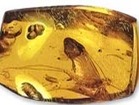Amber is a traditional souvenir from Lithuania
2010-10-04 13:29
The climate was mainly warm, turning to subtropical. Possible reasons for pathological overproduction of resin in amber trees were consequences of natural disasters and climate changes: lightning, early frosts, cloudbursts, increased concentration of soil salts and air humidity. Because of intensive resin exertion in the beginning of the Oligocene period amber forests were growing sickly very slowly.
The process of amber formation of resin includes many lasting changes and stages: polymerization, oxidation, isomerization, fermentation and the so-called ripeness process in alkaline soil of the Sambian peninsula, outputs of the Eocene period. Here resin had once and for all turned into amber.
Very few inclusions of plants are found – about 300 pieces that make approximately 0.4%. In the Palanga amber Museum only those remnants of plants remained whole that had been totally covered by resin and had no contact witch air.
Every piece of amber is of its early form, which reveals the process of its formation. If weathering had not damaged amber, water and ice, it could have retained its early form unchanged. Amber pieces are divided into those that had formed inside the trunk. The former are in the form of a drop (79%) amber stalactites, drops, icicles, pieces of amber in amber. The latter are in the form of the inside trunk (12%): pieces of resin in the bark or between the trunk and the bark. These are bark lamellae, pieces with bits of the bark.
CHARACTERISTICS OF THE BALTIC AMBER
Today more than 250 kinds of the Baltic amber are known. They are determined by color is yellow. Limpidity degree and color intensity depend on the number, size and arrangement of the smallest opaque admixtures in amber.
Flomin (muddy) stones are limpid; it is easy to polish them. Bastard stones are turlid, having lots of air bubbles. They may be blotted with clods of pearl color (white, light yellow), yellow or brownish. Bone amber is white or ivory, opaque, sometimes with bluish tint.
Physical and chemical characteristics of the Baltic amber are extremely various. Its hardness according to Mohs` scale is 2-3, but sometimes it reaches 10. The Baltic amber is easily processed, cut, drilled or polished. Amber density is from 1,05 to 1,096 g/cm 3.
Water of the Baltic Sea is not very salty. Amber density is little, so it floats in the water and waves coast it ashore. Because of its amorphous structure amber easily cracks. It also easily takes fire and burns in a smoking flame spreading a smell similar to that of incense. It is difficult to determine the exact fusion temperature of the Baltic amber.
When the temperature reaches 170*C, it becomes soft and sticky. This characteristic is used producing pressed amber. Amber fuses and disintegrates when the temperature is above 300*C. Only conofolium is left.
Under the effect of oxidation amber weathers and becomes darker. Because of oxidation amber covers itself with patina. Its thickness sometimes reaches some millimeters.
Amber is resistant to non-oxidizing chemicals and organic solvents. It melts being soaked in methyl alcohol (of 11,3%), turpentine (of 16,9%), ether (of 18.8%), acetone (of 23.3%). Chemical composition of the Baltic amber (succinct) is: 78.55% of coal C, 9.64% of hydrogen H, 11,81% of oxygen O. There is 3-8% of amber acid (C4H6O4) in succinct.
The most effective method of investigating fossil resin is infrared spectroscopy. It helps to identity succinct quite precisely and to distinguish it from other fossil resins.
************
Are you satisfied with our travel and leisure guide? The best thanks from you we get, if you book a hotel, an air ticket or rent a car by clicking on the links below. After this, we get some commission, which do not charge you anything, but help us to take care of this portal. A payment is safe, not in our servers - our chosen partners take care of the payments and keep your data safe through SSL technologies. Reliable partners have the widest choice of hotels, air companies, rent-a-car points. They can offer you the best prices and no extra charge. Our personnel tried those services travelling over the world and were very satisfied.


